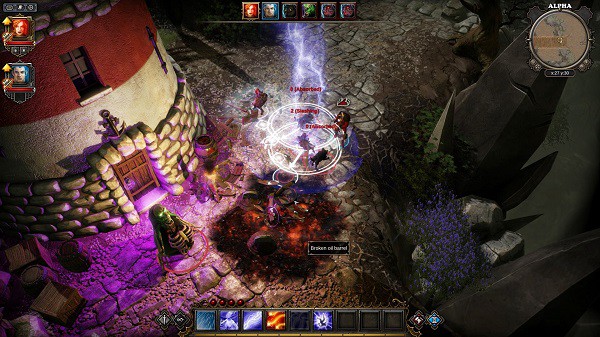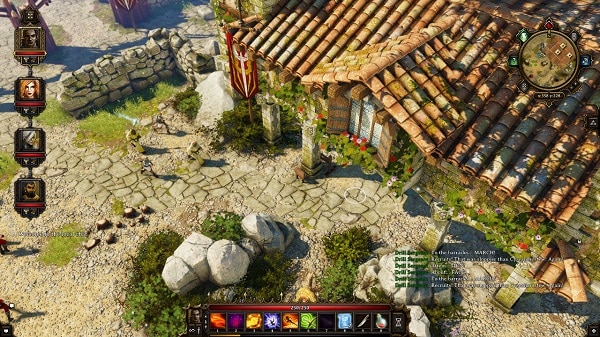
Divinity: Original Sin
Developed by Larian Studios
Published by Focus Home Entertainment
Available for PS4, Xbox One, Linux
Divinity: Original Sin is a fantasy role-playing game developed by Larian Studios and published by Focus Home Entertainment. It has a single player campaign, but, and this is something I believe is missing from many games these days, it also has the ability to play local multiplayer. In addition, it allows you to choose your ‘style’ of adventure. Are you more focused on story and exploration? Try ‘Explorer’ mode. Like combat? Choose the ‘Classic’ mode. Looking for something more hardcore? Take the challenge of one death with the ‘Tactician’ mode. Finally, the ‘Honour’ mode caters to the MOST hardcore of fans, combining the ‘Classic’ mode with the ‘Tactician’ mode.
You control two fully customizable characters. They can be male and female, male and male, female and female; the pairing is up to you. Names, portraits, face, hair, hair color, underwear, everything is up to you. I personally love that level of detail. It allows you to get creative, but puts enough stipulations on it that you don’t spend the first 6 hours of the game trying to decide which shade of aquamarine is best for your characters frosted tips. Then comes the class system.
Class systems have forever been the backbone of good RPGs. There are numerous combinations available in Divinity: Original Sin. You could use two rogues, and sneak your way through everything. Or use a warrior and a wizard, and deal damage up close while buffing from afar. Or you could go all offense with two warriors. With 11 classes, you’ll be sure to find two classes that go together in a way that works. Once you’ve found a party combination that works for you, you’re cast into the game.
You’re quickly driven through the Reader’s Digest version of ‘Source’; a deadly type of magic, and its users: Sourcerers. You play a pair of ‘Source Hunters’; people given the task of hunting down and eliminating Sourcerers. You’ve been dispatched to the port town of Cyseal to investigate the murder of a Councilor named Jake. On your way to town, you come across a group of Sourcerers, who before fleeing, mention something called a ‘Blood Stone’. The leader of the trio summons some skeletons before leaving with the others.

Combat is played out in turns. At the top of the screen you will see the order for all parties in the fight. On the left hand side near the top, you can see your two characters, and their respective health bars. On your turn, you can move, attack, or select ‘skills’ from your hot bar. A skill can be anything from healing allies to dealing huge amounts of damage to enemies or buffing your own skills – your options are determined by your class. After combat, you gain XP (used in leveling up), and can pick up items dropped by your enemies.
So after dispatching the skeletons, your team decides to investigate a nearby dungeon, on the basis that the ‘Blood Stone’ might have come from there. You make your way through the dungeon, and battle an Undead being at the end, named Ragequin. Ragequin mentions the ‘Blood Stone’ as well, which lends credence to it being important. You leave the dungeon, and finally make your way to Cyseal. Once there, you are instructed to go meet with the Legion Captain Aureus, in order to get permission to enter the room that Jake was murdered in. Upon entering the room, you see a scene of carnage. You touch a stone in the middle of the room, and are thrust into the ‘End of Time’.
The Chronicler at the ‘End of Time’, Zixzak, hurriedly explains that a void is destroying the universe, and takes you to meet the Weaver of Time. The Weaver explains that though she sees you in front of her, she has no memory of you in her threads. However, with your presence in the ‘End of Time’, the void is slowing, and she believes you are important to stopping the void. She explains that the stone is called a Star Stone, and that the Sourcerers are trying to collect the pieces of the Star Stone as well. The Weaver tasks you with collecting the shards first, before Zixzak sends you back to Cyseal to meet with his agent, who will assist you on your quest. With this, you are started on your quest to save the world.
Let’s rewind for a second. Now, back in 2004, a game called Champions of Norrath: Realms of Everquest was released. It was an action role-playing game, much in the same vein as Divinity: Original Sin. I had come across this game around the time it was released, and thinking that the case art made it look cool, decided to pick it up. At that point, a friend of mine, Justin, and I were lost to the world. This game completely drew us in. We played through it multiple times, with multiple characters. We lost many weekends to the game.
When I started playing Divinity: Original Sin, I could have sworn I was playing a spiritual successor to Champions. It has such a familiar look, feel and sound, and it immediately brought me back to those many weekends Justin and I sank into Champions. The art in Divinity: Original Sin is a huge plus for me. It has a very ‘updated PS2’ style to it; it has a built in sense of nostalgia for anyone who cut their teeth on the PS1/2. The dungeons have a very ‘lived in’ feel to them; the sense of age is very well done. Bits of dust will fall from the ceiling, the stones are chipped and falling apart, Mother Nature is trying to take it back. It’s a stark contrast to the towns and open areas. The water in the beaches and towns look amazing, complete with ripple effects when you walk through it. A nice touch is that the blood after combat follows the same rules; splashing when you step in it. The beat down paths are a great touch, and the buildings looks solid but distressed; a real look of history to them. It’s always great when the developer pays attention to small little things to really build in a sense of verisimilitude.

The art is only aided by the sound effects. Opening giant stone doors, for example, is joined by the sound of stone scraping against stone. The transition from water to grass is flawless, as is the sound of your sword contacting your enemy. The voice acting is a huge plus. Some games fall down when they give the main character(s) a voice; but Divinity: Original Sin nails it. Giving the player the choice of 3 different voices to give them some personality was great. It adds immersion, as does hiring performers who care about their character. I never encountered a character with the feeling of “I hope this guy isn’t a staple, I can’t stand his voice”, everybody really pulled me in.
The map is very well done. For instance, when you are given new quests, markers are automatically added to the map, so you typically know where to go. Plus, when you go to important locations, it adds a marker to tell you what it is. Additionally, you can add and name your own markers. However, sometimes dialogue cues are tricky and the quest log doesn’t update. So you have to scour the dialogue brief (located conveniently in the pause menu), and use context clues to find where to go.
One of my favorite game mechanics in Divinity: Original Sin is a minigame used when you’re trying to convince another character, or even your partner, to see things your way. Say you want to know the whereabouts of something, and decide to intimidate someone to find it. You’ll then enter a “rock, paper, scissors” style minigame with the person. You play in rounds until one of you beats the other. If you win, you convince the person. If you lose, they stay quiet. This same mechanic can be used to settle arguments between your characters as well. It’s a very innovative way to introduce character development.
On the topic of character development, throughout the game you are presented with dialogue options that determine your characters growth. For example, there is a point where you can either help or hinder a man stealing a fish. If you help him steal the fish, your traits will shift in a different direction, and people will respond to you differently. The kicker though? The dialogue options are presented separately, allowing your two character to grow into two dynamically different people.
These traits will also effect how shopkeepers interact with you. Shopkeepers that like you are more inclined to give you better deals; while those that don’t like you will be less geared that way. You can raise someone’s opinion by giving them gifts, or you can lower it by stealing, or just being a jerk in general. Again, a wonderfully innovative system introduced in Divinity: Original Sin.
All in all, Divinity: Original Sin is a wonderfully addictive game. With the abundance of side quests, customization options, numerous class combinations, and deep campaign, it’s sure to occupy even the most rigid of RPG gamers. If you love strategy, exploring, story, or any combination of the three, you’ll fit right in with Divinity: Original Sin.


